Advertisement
‘The Mayan stands for the good things in my life — health, sanity, and freedom — all the positive values’ — David Crosby
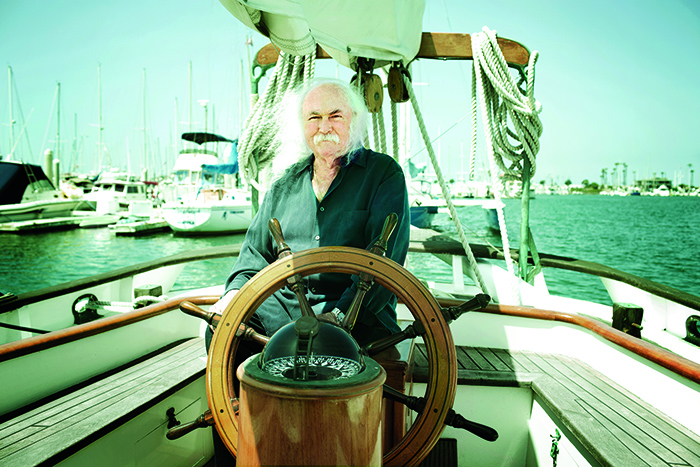
n 1967, between The Byrds and CSN, David Crosby first saw the 1947 John Alden-designed schooner Mayan (opposite), which he would own until 2014. He sailed her from Fort Lauderdale to San Francisco with Graham Nash and others in 1970, then several times back and forth to Hawaii. Photo: Annie Tritt
In the months just before and after 1969, as clean-cut crooners and girl bands and Motown acts gave way to long-haired singer-songwriters who filled football stadiums, the Great American Songbook tilted on a fulcrum. At the center was a mustachioed scamp with sparkling blue eyes – and a wooden ship designed 40 years earlier by the great John G. Alden.
David Crosby was drifting more or less aimlessly in South Florida, circa 1967, when he spotted the schooner that would anchor his life for the next four decades. “One day in Fort Lauderdale, driving over one of the bridges,” wrote Crosby in his 1988 memoir “Long Time Gone,” “I saw her, right there in Port Everglades.”
What he saw was Design No. 356B, which John Alden’s office in Boston had resurrected in 1946 for a WWII Navy captain named Charles Allen from a 1928 design. She was 60 feet on deck, 62 feet to the head of the mainmast, intended to transit the Intracoastal Waterway between New York and Florida, then cross over to the Bahamas and the Caribbean. Charles’s son Paul Allen led the team that built her in six months near Belize City, using Honduran mahogany for the frames, yellow pine for the planking, and teak for the decks. A lifting centerboard kept her draft to 4½ feet. She was called Mayan.
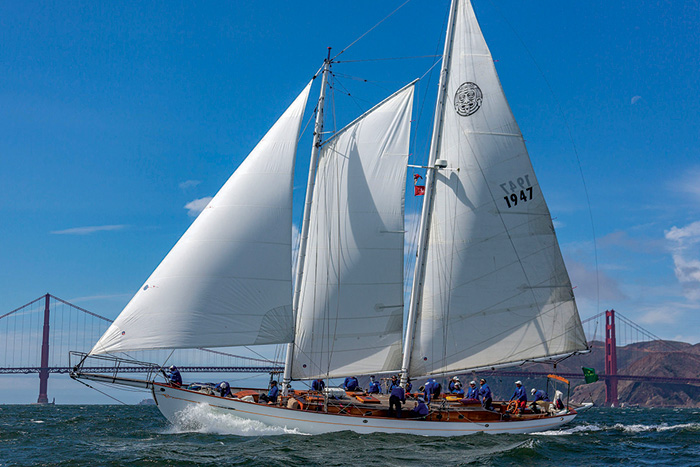
After selling Mayan to current owner Beau Vrokyk in 2014, she underwent a full refit and regularly races on the West Coast. Visit medium.com/schoonermayan to read more on Mayan’s present life. Photo: Rolex/Daniel Forster
Crosby had recently invented a new musical genre, then been fired by the very band mates with whom he invented it. In those days just after the John F. Kennedy assassination, The Byrds (Crosby with Jim “Roger” McGuinn, Chris Hillman, and others) had been stewing in the rapidly changing musical ingredients of the day – the two-part vocal harmonies of The Everly Brothers, Bob Dylan’s smorgasbord of a folk lyric as heard in 2/4 time on a scratchy demo, that jangly 12-string Rickenbacker guitar that George Harrison carried through “A Hard Day’s Night.” The Byrds’ April 1965 “Mr. Tambourine Man” at once inaugurated folk-rock and a so-called California Sound that supplanted blues as the basic element of rock music.
But with massive instant success came massive competing personalities. Crosby’s radical pronouncements and scene-stealing at live shows grated on his mates’ nerves, as did his surprise performance with Buffalo Springfield at the 1967 Monterey Pop Festival in place of an absent Neil Young. When The Byrds were choosing the songs for their second album, Crosby insisted on his own composition “Triad” – a musically drifty song that advocated for threesomes as the fundamental unit of domestic arrangements – and rejected the cover of Carole King’s “Goin’ Back” that the other Byrds preferred. In October 1967, McGuinn finally kicked Crosby to the curb.
Wind and water
Crosby had sailed 8½-foot Sea Shell dinghies as a kid in Santa Barbara, and it was to those indelible memories and experiences that he returned while he nursed his bruised ego. “Sailing alone in that boat was a transforming experience,” he recalled of his early teenage years. “I used to sail outside the harbor and beyond the outer marker. Eventually I got real adventuresome with it, and they finally said they didn’t want me in the Sea Shell Club anymore. It evolved into my usual problem with authority.” While the young Crosby was out there breaking rules, he was also absorbing the beautiful things he saw around him – the schooner Gracie S that would become Sterling Hayden’s famous Wanderer, and the graceful old-school designs of John Alden. And so, after leaving The Byrds and gravitating toward the sailors of Coconut Grove, Florida, he was already primed for his first sight of Mayan.
“They wanted $60,000 for her,” wrote Crosby. “So we let it be known around town that I was a dumb hippie from the coast who didn’t know anything. Then my friend Bill Bolling started rumors that she had rot – a lot more rot, structural rot, than she had. A few weeks later, I showed up and said, ‘Gee, nice boat,’ and made a lowball offer. I got the Mayan for $22,500, which I borrowed from Peter Tork, who was flush with Monkees money. It was the best money I ever spent.” Arguably, David Crosby had “Daydream Believer” to thank for the most stable home in the next four decades of his monumentally unstable life.

Mayan playground
Meanwhile, the elements of his second act were coming together. Old friends were stopping by Mayan to visit. One of them was Buffalo Springfield’s Stephen Stills. And when Jefferson Airplane came through South Florida, Paul Kantner and Grace Slick stayed aboard Mayan for a time.
“Grace and I were playing down in Miami somewhere and had a little break,” Kantner recalled. “So we took some funky seaplane out to the middle of some atoll in the midst of god knows where, landed in the lagoon where David was anchored, and stayed for a weekend or a week or whatever it was.” Never mind that Kantner’s “lagoon” was a Bahamian bank or his “atoll” on a cay. Together on Mayan, David Crosby, Stephen Stills, and Paul Kantner wrote “Wooden Ships” – the one song that would be performed by two bands in two separate sets at Woodstock, come August 1969, and spur at least two musical rebuttals, one from Jackson Browne (“For Everyman”), and another from Neil Young (“Hippie Dream”). Cultural critics can debate the layered meanings embedded in “Wooden Ships” or offer their highfalutin reflections on late-20th century nihilism in an age of nuclear Armageddon. Paul Kantner remembers it differently.
“’Wooden Ships’ was written for David’s sailing thing,” Kantner wrote. “David stole the first verse of it off a church, where they had a neon sign where they’d put little sayings: IF YOU SMILE AT ME, et cetera. We just ripped it right off. Part of the artistic process. We used to call it ‘the folk process.’” Meanwhile, Crosby was making new friends, too.
“I was folksinging in Coconut Grove at the Gaslight South,” Joni Mitchell told her biographer, David Yaffe, in 2015. “I hadn’t made a record yet. David had just purchased the boat that he loved. I fell into his merry company, and we rode bikes around Coconut Grove, and the winds were warm, and at night we’d go down and listen to the masts clinking down on the pier. It was a lovely period, and soon we became romantically involved.”
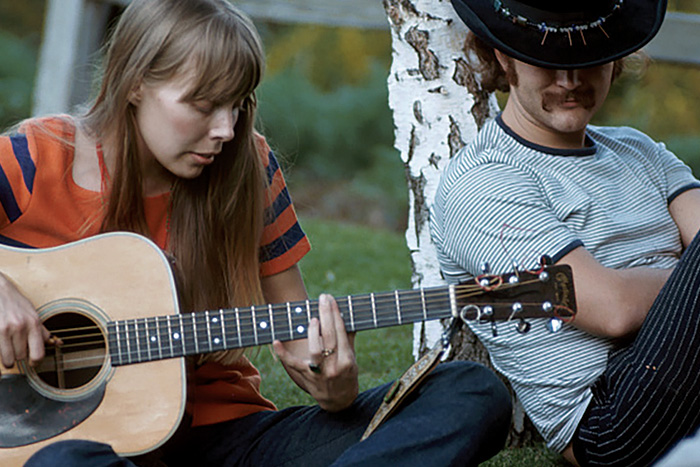
Photo: Getty images/Henry Diltz
In harmony
They returned to Los Angeles together, and David Crosby used his music-industry connections to procure a deal with Reprise and produce “Song to a Seagull,” released in March 1968, the first record of Joni Mitchell’s magnificent body of work. In Los Angeles, they’d eventually split tacks romantically yet remain good friends, and Mitchell bought the bungalow with Tiffany stained-glass windows at 8217 Lookout Mountain Avenue in Laurel Canyon that would become one of the great cultural salons of their generation.
It was in that house, depending on whose version of events you believe, that Stephen Stills, David Crosby, and Graham Nash of The Hollies first sang together.
“In Joni’s living room,” Nash told Terry Gross in a 2013 Fresh Air interview, “David said to Stephen, ‘Hey, play … that song we were just working on.’”
The song was “You Don’t Have to Cry.” Nash listened, then asked them to play it again. When they finished, he said, “Bear with me. One more time.” On the third pass, Nash added a second harmony above Stephen’s melody. “Whatever vocal sound that Crosby, Stills & Nash has was born in less than 40 seconds,” Nash told Terry Gross. “No years of rehearsal to get that vocal blend. It happened instantly. And we all knew it – so much that we stopped the song, and we all started to laugh.”
In the typical musical scale used in folk music, there are seven notes (the piano’s white keys). But in a chromatic scale, there are 12 notes (the white and black keys). Harmony singers in folk music usually constrain themselves to the scale’s first, third, and fifth notes. In CSN, Crosby’s innovation was to use the whole chromatic scale as he’d heard in jazz and classical music. “All the intervals have emotional things to them,” Crosby wrote. “What we did, which made me extremely proud, was sing a lot of nonparallel stuff. I’d move the middle part around in internal shifts that kept it happening.”
The union of their voices changed the world of music, and the season that followed in that spring and summer of 1969 was an idyll. “We were all in love with each other,” Nash recalled. “I was in love with Joni. Stephen was in love with Judy Collins. David was in love with his girlfriend Christine Hinton.” The music they recorded was summery and light. With its scenes of domestic bliss, Graham Nash’s “Our House” gave Joni Mitchell’s Laurel Canyon bungalow a permanent place in the Great American Songbook.
Playlist: Time on Mayan inspired musical greats
- “All I Have To Do Is Dream,” The Everly Brothers (The Very Best of the Everly Brothers)
- “Mr. Tambourine Man,” Bob Dylan (The Witmark Demos: 1962–1964. The Bootleg Series Vol. 9)
- “A Hard Day’s Night,” The Beatles (Hard Day’s Night)
- “Mr. Tambourine Man,” The Byrds (Mr. Tambourine Man)
- “Triad,” The Byrds (unreleased on The Notorious Byrd Brothers; included on Never Before, 1987)
- “Goin Back,” The Byrds (The Notorious Byrd Brothers)
- “Daydream Believer,” The Monkees (The Monkees 50)
- “Wooden Ships,” Jefferson Airplane (Volunteers)
- “Change Partners,” Stephen Stills (Stephen Stills)
- “Our House,” Graham Nash and Joni Mitchell (demo on Déjà Vu: 50th Anniversary Deluxe Edition)
- “Willy,” Joni Mitchell (Ladies of the Canyon)*
- “Wooden Ships,” Crosby, Stills & Nash (Crosby, Stills & Nash)
- “The Lee Shore,” Crosby, Stills, Nash & Young (4-Way Street) z “Man In the Mirror,” Graham Nash (Songs for Beginners)
- “Critical Mass/Wind on the Water,” David Crosby, Graham Nash (Wind on the Water)
- “Page 43,” Graham Nash & David Crosby (Graham Nash & David Crosby)
- “Laughing,” David Crosby (If I Could Only Remember My Name)
- “Sing My Songs to Me / For Everyman,” Jackson Browne (For Everyman)
- “Hippie Dream,” Neil Young (Landing on Water)*
- “For Free,” David Crosby, Sarah Jarosz (For Free)
- “Wooden Ships,” Jason Isbell and the 400 Unit, with David Crosby (Live from the Newport Folk Festival 2018)
Listen to this playlist on Spotify
*Songs not available on Spotify
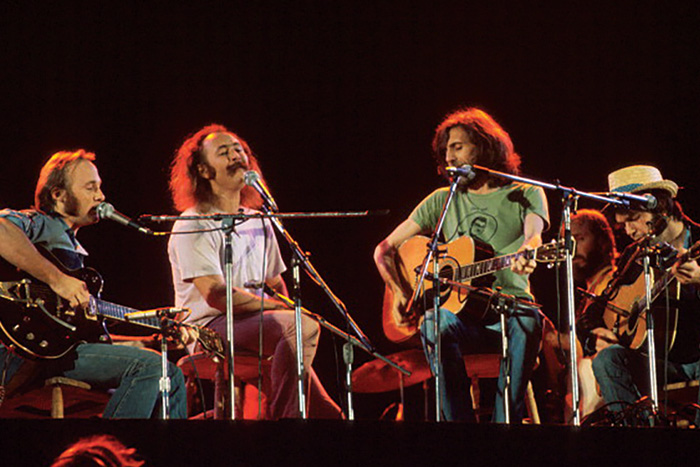
Photo: Getty images/Michael Putland
Mayan saved his life
Through it all, David Crosby’s heart was never far from Mayan. As soon as the recording was completed in March 1969 for “Crosby, Stills & Nash,” their first studio album, Crosby and Christine Hinson straightaway returned to the schooner.
“We put out the album, and I took off and went sailing,” he recalled. “We went to the Bahamas, and I wasn’t around when the thing got big. But I heard – it filtered down to Florida, which was way behind the times in those days. All of a sudden, it was all over the radio. I missed the excitement of sitting in LA, in the biz, getting saturated with winning. But it’s probably a good thing, given my ego.”
The thing got big, all right, going on to sell 4 million copies. It set them up to headline the Woodstock Music and Art Fair in August 1969 – arguably the pinnacle of any sunshine feelings among the musicians, which by then had come to include Neil Young. (“I lost my ampersand,” quipped Nash.)
The season that followed was marked by heartbreak, acrimony, and tragedy, all fueled by the cocaine that had come to define their scene. Their second album, CSN&Y’s “Déjà Vu,” mostly recorded in fall and winter 1969, was very different from the first. “I was not with Joni anymore,” recalled Nash. “Stephen was not with Judy Collins. And Christine had been killed in a car accident. It’s a fine record, ‘Déjà Vu,’ but it’s a very dark, bleak album.”
After Christine Hinson died, Nash grew deeply worried about his friend. “I watched a part of David die that day,” Nash wrote. “He seemed suicidal, and I feared greatly for his life. He needed a change of scenery, pronto.”
That change of scenery turned out to be a seven-week, 3,000-mile voyage from Fort Lauderdale to San Francisco in January and February 1970, between the recording and release of Déjà Vu. In addition to Crosby and Nash, the crew for the trip included Ronee Blakely, a singer-songwriter who would go on to win a Best Supporting Actress nomination for her role in the 1975 Robert Altman film “Nashville.” And Joni Mitchell was aboard for the Jamaica-to-Panama leg – an experience she very much did not enjoy. “Joni remembered the sailboat ride as tortuous,” wrote her biographer.
“We hit seas that were completely abnormal, with 10-story swells,” recalled Joni. “I got a full body rash. They wrapped me in a sheet and tied me to the railing because of these swells. And I spent three days throwing up over the side. I hit the shore and just ran, so glad to be on the ground.”
Like any good voyage, this one produced different tellings of the same event from all aboard. Off the coast of Cuba, Nash wrote “Man in the Mirror.” On the Pacific side they encountered a blue whale, which kept the crew entranced for hours, an experience Nash captured in “Wind On The Water.” And for Crosby, the trip had been exactly the balm he needed. At the dock in Sausalito, Mayan became the salon Joni’s bungalow had been in an earlier season. Crosby wrote “Lee Shore,” “Page 43,” “Carry Me,” and other songs aboard the boat. Jackson Browne lived aboard Mayan between recording his first and second albums.
“David was feeling better; he was ready to rock,” Nash wrote of their return to public life in spring 1970 after the voyage. “Croz and I were both in great shape, tan and trim, clear-eyed, all those good things. We had the songs, as well as the love and trust for each other. The music and the Mayan had literally saved his life.”
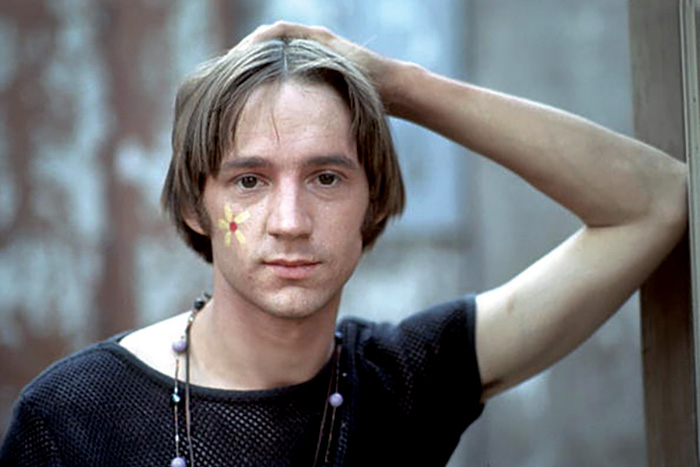
Photo: Getty images/Michael Ochs Archives
And he played real good
David Crosby, 81 years old, died on January 18, 2023. In the intervening years, he had many good moments and some spectacularly bad moments, marked by three heart attacks, one liver transplant, and several convictions for possession of drugs and firearms, with hard prison time in Texas and Florida in the mid-1980s. Through it all, he was an undependable band mate. “All the guys that I made music with won’t even talk to me,” said Crosby in the 2019 documentary “Remember My Name.” “All of them.”
Still, in the last years of his life, he kept making good music, some of his best, and much of it with musicians one and two generations younger: Sarah Jarosz, Jason Isbell, the Lighthouse Band. (For a breath of fresh air, check out their August 2019 NPR Tiny Desk Concert.) David Crosby named his final album “For Free,” for the song Joni Mitchell first performed at the 1969 Newport Folk Festival, a song she wrote in that long-ago idyllic summer.
As for Mayan, Crosby sold her in 2014 to Beau Vrolyk, a man who has sailed extensively in Central America and the South Pacific and with whom the 1947 schooner is enjoying a marvelous rebirth. Vrolyk routinely brings aboard some of the Bay Area’s best sailors and yacht designers – Bill Lee, Stan Honey, Sally Lindsay-Honey, and others – and regularly introduces young people to Mayan and the good things that sailing can bring to a life.
“I was always at my healthiest and happiest aboard Mayan,” Crosby wrote.
